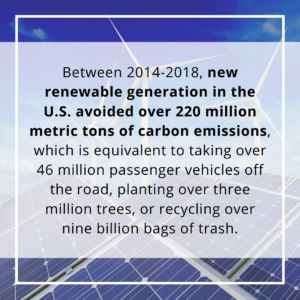Fact Check: Planet of the Humans Gets It Fundamentally Wrong on Renewable Energy
By: Lesley Hunter
May 12, 2020
Renewable energy today provides nearly a fifth of America’s electricity generation, and that share continues to increase as renewable power improves the performance of our electric system, reduces carbon emissions and provides numerous other benefits for the environment, public health and the economy. However, you wouldn’t learn any of these facts from watching the new Michael Moore-produced documentary Planet of the Humans. The film has already been widely panned for being riddled with errors and outdated information. We examine some of the documentary’s most egregious claims about renewable energy and set the record straight below.
Claim: Renewable energy is not displacing fossil fuels like coal, natural gas and oil.
Fact: Renewable energy has significantly displaced fossil fuel generation over the past decade.
- Renewable energy has grown from 10% of the nation’s total power generation in 2009 to 19% in 2019, despite essentially flat electricity demand. (Source)
- In regional power markets, gains have been even more significant. For example, in the Southwest Power Pool (SPP) – which covers 14 states and serves 18 million Americans – renewable generation increased from 5% to 33% of the SPP’s power mix over the same period. (Source) (Source)
- According to the U.S. National Renewable Energy Laboratory, renewable generation technologies and enhanced grid flexibility are “more than adequate to supply 80% of total U.S. electricity generation in 2050 while meeting electricity demand on an hourly basis in every region of the country.” (Source)
Claim: Renewable energy isn’t reliable.
Fact: Renewable energy operates reliably every day.
- Multiple regional studies have affirmed that power systems with high renewable penetration operate reliably. (Source) (Source)
- In fact, U.S. military installations and other critical facilities rely on behind-the-meter renewable energy coupled with energy storage and microgrids for a secure, renewable energy supply. For example, once a new energy storage unit is commissioned this summer, the Pacific Missile Range Facility in Hawaii will have the ability to manage its solar array as a microgrid to provide power to its mission-critical activities in the event of a short- or long-term grid outage, in place of diesel generators. (Source)
- Renewable energy can even enhance power reliability under extreme weather conditions, not requiring disruptable fuel supplies and bouncing back quickly from interruptions. According to the North American Electric Reliability Corporation (NERC), fossil generation facilities relying on natural gas and coal are the largest sources of cold weather-related power outages, as low temperatures damage natural gas pipelines and freeze coal stockpiles. (Source) When coal-fired generation failed during the Australian heatwaves of January 2019, large-scale solar farms saved the day by running at 93% of their maximum output. (Source)

Claim: Renewable energy technologies have higher lifecycle greenhouse gas (GHG) emissions than fossil fuels.
Fact: Lifecycle GHG emissions – which are the sum of emissions generated from all energy project stages, including construction, operation and decommissioning – are more than 85% lower for renewable energy than for fossil fuels.
- Based on harmonized data, coal-derived electricity averages 975 gCO2/kWh and natural gas averages 475 gCO2/kWh. By comparison, wind averages 11 gCO2/kWh and solar PV averages 55 gCO2/kWh. (Source)
- Between 2014-2018, new renewable generation in the U.S. avoided over 220 million metric tons of carbon emissions, which is equivalent to taking over 46 million passenger vehicles off the road, planting over three million trees, or recycling over nine billion bags of trash. (Source)
Claim: The cost of renewable power is too high to transition to a renewable energy economy.
Fact: Today’s renewable energy is cost-competitive with all forms of energy.
- Since 2009, the unsubsidized, levelized cost of wind energy has declined by more than 70% and the unsubsidized, levelized cost of solar power has declined by nearly 90% in the U.S. (Source)
- As a result, the unsubsidized, levelized cost of utility-scale wind and solar is now cheaper than coal and at parity with natural gas combined-cycle generation. (Source)
The dangerous falsehoods and misplaced critiques of renewable energy in Planet of the Humans does a disservice to the renewable energy sector and the global fight for a healthy climate. The truth is that renewable energy and enabling grid technologies can deliver the emissions reductions that science requires, while providing businesses and consumers the abundant, affordable and reliable pollution-free power they want and deserve.
Join leaders from across the renewable energy sector.

What will our next 20 years look like? Here’s the truth: they’ll be better with ACORE at the forefront of energy policy.
Shannon Kellogg
Amazon Web Services (AWS)
